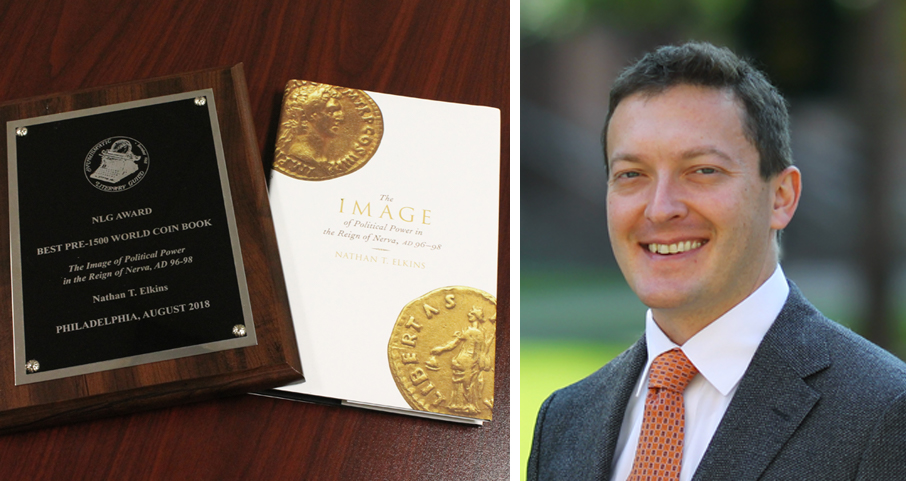Baylor Art History Professor Wins National Award for Book on Roman Coin Imagery


Dr. Nathan T. Elkins's The Image of Political Power in the Reign of Nerva, AD 96-98 has received a Best Book Award (Pre-1500) for 2018 from the Numismatic Literary Guild.
Contact: Whitney Richter, Director of Marketing and Communications, Office of the Vice Provost for Research, 254-710-7539
Written by: Gary Stokes, Office of the Vice Provost for Research
WACO, Texas (December 17, 2018) – Baylor associate professor of art history Dr. Nathan T. Elkins has received an award from the Numismatic Literary Guild for his 2017 book The Image of Political Power in the Reign of Nerva, AD 96-98 published by Oxford University Press. The award was announced August 16th during the American Numismatic Association's World's Fair of Money held August 14-18 in Philadelphia, Pennsylvania. The book was nominated in the Best Specialized Book category, winning the award for Best Pre-1500 World Coin Book.
An acknowledged authority in Greek and Roman art and archaeology, Elkins's range of expertise extends to coinage and coin iconography, topography and architecture, and sport and spectacle. Although he teaches in the Department of Art and Art History, his training is in a discipline that some might find surprising.
"I'm not really an art historian, I'm an archaeologist and a classicist," Elkins said. "I say I'm not really an art historian because when people think about art history, they think about the Renaissance, or the 19th Century, or the 20th Century, or what's happening now. To study ancient objects and images, you have to approach the subject very differently. If you think about Renaissance paintings, for example, [they were] never buried, and you know it was in this cathedral because it's been in that cathedral for four or five hundred years, whereas the Roman civilization has been long vanquished; it's been buried, so their objects have to be studied in a different way.
Elkins' book examines the political role of images on Roman coins during the reign of the emperor Nerva. Following the assassination of the emperor Domitian in A.D. 96 by conspiring court officials, Marcus Cocceius Nerva became Roman emperor at the age of 65, after a long career of imperial service under Nero. Nerva worked to restore many of the freedoms lost during Domitian's authoritarian regime, especially for the senatorial nobility, yet his brief sixteen-month reign—cut short by his death from natural causes—has left him something of an understudied figure in the line of Roman emperors. Only a few texts, a dozen or so portrait sculptures, and coins remain for scientists and scholars to examine. Elkins's book demonstrates that imagery on coinage struck by the Roman mint during Nerva's reign offers significant insight into the relationships between the Senate, the Roman people, and the emperor, as well as Nerva's principles, politics, and policies, both in Rome and in the Empire at large.
Elkins explains: "If you think about how people were getting messages from the central government, what you have is the coinage. Unlike modern coins where we have the same design for a hundred years like we do on American coins, Roman coins were constantly changing—it was immediate, it was topical. With the emperor Nerva, even though he only ruled sixteen months, there are over a dozen unique images that appear on his coinage in that amount of time. And the coinage of other emperors was similar. It was topical, it was constantly responding to current events, victories, building programs, the virtues of the emperor and so on."
Not only were coins constantly changing to represent changing leadership, events and other timely topics, Elkins says coins with certain designs were often supplied to specific populations and regions of the Empire. For example, coins used to pay soldiers in faraway garrisons carried images of victories in battle and military slogans. Those that circulated in the city of Rome itself might carry phrases and images extolling the relationship between the emperor and the Roman Senate or the emperor and the plebs (the lower class of freeborn citizens). Throughout the empire, more coins bore generic platitudes about liberty, good luck, prosperity, or other concepts. This targeting of coin design and distribution gives archaeologists a valuable tool in establishing the location, socioeconomic status, and mobility of segments of the Roman population, and illustrates the state's awareness of the relevance of images to its diverse peoples.
Today, many ancient coins are pillaged from archaeological sites, some by gangs with ties to organized crime and some even by terrorist groups. Elkins consults with various government and law-enforcement agencies to identify and evaluate coins and other antiquities thought to have been looted and smuggled. In one case, he examined some 60,000 coins seized from a dealer in Eastern Europe. "They still had dirt on them," he said.
For that reason, Elkins does not encourage buying ancient coins without a verifiable pre-1970 provenance; that is the year UNESCO implemented its Convention on Prohibiting and Preventing the Illicit Import, Export and Transfer of Ownership of Cultural Property. In addition, he warns that the industry is so rife with fakes and reproductions that uninitiated collectors are almost certain to be scammed
In addition to his researching Roman coins and his teaching, Elkins also directs Baylor's Undergraduate Research and Scholarship Achievement (URSA) program, is Editor (ancient world), of the American Journal of Numismatics, and is a Fellow of both the American Numismatic Society (New York) and the Royal Numismatic Society (London).
A summary and reviews of The Image of Political Power in the Reign of Nerva, AD 96-98 can be viewed here.
The American Numismatic Association is a Colorado Springs-based nonprofit organization dedicated to providing tools and resources for numismatists and coin collectors, and is dedicated to fostering the love of the hobby for generations to come.
The American Numismatic Society is an organization dedicated to the study of coins, currency, medals, tokens, and related objects from all cultures, past and present. The Society's headquarters in New York City has the foremost research collection and library specialized in numismatics in the United States. These resources are used to support research and education in numismatics, for the benefit of academic specialists, serious collectors, professional numismatists, and the interested public.
The Numismatic Literary Guild is a nonprofit organization composed of editors, authors, writers, bloggers and content producers who cover news and feature stories about all forms of money, medals and tokens as collectibles. This year marks the NLG's 50th anniversary.